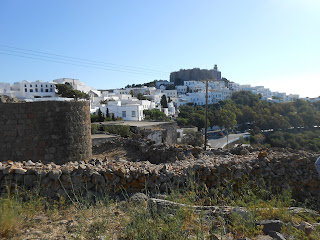After all were aboard, we headed over to Patmos, a Greek island 50 nautical miles from the port of Kusadasi.
 |
| The photo below is a zoom in of this photo above. |
It's very dry and desert-like. Water (or lack thereof) would be a big problem.
View of a castle-looking fortress.
We rode a tour bus and stopped at some windmills. They have been restored.
Flat roofs. White buildings. Blue Water. Below is our bus. Oh, Mike stayed behind on the ship during this short excursion to Patmos. He was very worn out after hiking around in Ephesus. One excursion per day was all he could do comfortably. And even then, he wasn't particularly comfortable, what with sore knees and feet.
We asked about the green, leafy branches and twigs strewn around the street. Our guide indicated that there must be a wedding that day. Tradition dictates that fresh greenery is placed along the pathway from the bride's home to the place where the wedding will be. In this case, it was the "City Hall" building and we happened to be standing in the square in front of it.
 | |
| Sideways photo of the city hall-type building |
Some of the skinny paths we walked had bridges over them, walkways from one building to another. This is what was under the bridge- small sticks. None were over 3 inches in diameter. I hope there were multiple layers of wood. And the walks had whitewashed sides, and some had coverings over them. Below, you can see that door "frames" were not white-washed. The Greek Cross is carved over the door frame.
Narrow "streets" for pedestrian traffic only. Obviously, from the greenery on the ground, this is the street where today's bride lives!
Above, this one (sorry it is sideways) is a church door. I don't know what the little door to the left is. But the wood is old, the stones are old. Again, there are many, MANY churches in Greece. Lots and lots of worship spots and many are teeny tiny.
This guide (whose name escapes me) was the one who told me that homes were white washed in the country because they were ordered to do so many years ago by a ruler. By using the lime white washing liquid, they found that it killed a lot of germs and kept people from getting sick. The white paint also helps to reflect heat away from the buildings, AND because they are very close together, there is more shade to help lessen the extreme heat of summer.
While driving the very narrow streets in this town nestled into a hillside, and on our way to the Monestery, we saw the bridal train of cars going up to the wedding. They had nice black (rental?) cars, all the people were honking. (Might have been because the hairpin curves didn't allow much visibility). All dressed in her white wedding dress, we got to wave at the bride as she was driven by in the first car. Along the windshield-wiper/hood area of her car was laid a big woven pile of pretty flowers and greenery. It reminded me of a large haku lei. It was quite pretty.
Our last stop on Patmos was the Grotto of the Apocalypse. No photos were allowed. Here's a quote from our ship's Daily Program:
"Please note that for entrance to the Monastery and Grotto of St. John, for both ladies and gentlemen, shoulders and knees should be covered. " Modesty is required.
The grotto was looking like a shrine and the guides attempted to maintain a reverent feel.
I spent from about 5 to 9 pm on Patmos, touring, and tendering to and from our ship. Mike and I had a late dinner together on the ship and then we went to bed. We didn't spend much time wandering around on the ship and exploring or participating in any activities.
It was a smallish-cruise ship, but there were other activities going on. It was a major activity for US to just both get showered and ready for the next busy day! ha.



























No comments:
Post a Comment